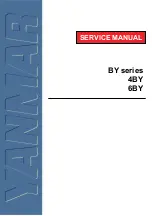
NOTE
a)
Max. 1010 kg/m³ at 15 °C, provided the fuel treatment system can reduce water
and solids (sediment, sodium, aluminium, silicon) before engine to the specified
levels.
b)
1 mm²/s = 1 cSt.
c)
The purchaser shall define the maximum sulphur content in accordance with
relevant statutory limitations.
d)
Additional properties specified by the engine manufacturer, which are not
included in the ISO 8217:2017(E) standard.
e)
Purchasers shall ensure that this pour point is suitable for the equipment on
board / at the plant, especially if the ship operates / plant is located in cold climates.
f)
Straight run residues show CCAI values in the 770 to 840 range and are very
good ignitors. Cracked residues delivered as bunkers may range from 840 to – in
exceptional cases – above 900. Most bunkers remain in the max. 850 to 870 range
at the moment. CCAI value cannot always be considered as an accurate tool to
determine fuels’ ignition properties, especially concerning fuels originating from
modern and more complex refinery processes.
g)
Sodium contributes to hot corrosion on exhaust valves when combined with
high sulphur and vanadium contents. Sodium also strongly contributes to fouling
of the exhaust gas turbine blading at high loads. The aggressiveness of the fuel
depends on its proportions of sodium and vanadium, but also on the total amount
of ash. Hot corrosion and deposit formation are, however, also influenced by other
ash constituents. It is therefore difficult to set strict limits based only on the sodium
and vanadium content of the fuel. Also a fuel with lower sodium and vanadium
contents than specified above, can cause hot corrosion on engine components.
h)
The fuel shall be free from used lubricating oil (ULO). A fuel shall be considered
to contain ULO when either one of the following conditions is met:
●
Calcium > 30 mg/kg and zinc > 15 mg/kg OR
●
Calcium > 30 mg/kg and phosphorus > 15 mg/kg
i)
The ashing temperatures can vary when different test methods are used having
an influence on the test result.
NOTE
Residual fuel grades are referred to as HFO (Heavy Fuel Oil). The fuel specification
HFO 2 covers the categories ISO-F-RMA 10 to RMK 700. Fuels fulfilling the
specification HFO 1 permit longer overhaul intervals of specific engine components
than HFO 2.
6-4
Wärtsilä 46F Product Guide - a19 - 1 December 2017
Wärtsilä 46F Product Guide
6. Fuel Oil System
Содержание 12V46F
Страница 1: ...PRODUCT GUIDE Wärtsilä 46F ...
Страница 44: ...This page intentionally left blank ...
Страница 52: ...This page intentionally left blank ...
Страница 78: ...This page intentionally left blank ...
Страница 102: ...This page intentionally left blank ...
Страница 124: ...This page intentionally left blank ...
Страница 144: ...This page intentionally left blank ...
Страница 162: ...This page intentionally left blank ...
Страница 186: ...This page intentionally left blank ...
Страница 192: ...This page intentionally left blank ...
Страница 194: ...This page intentionally left blank ...
Страница 197: ......
Страница 198: ......
Страница 199: ......
















































